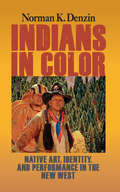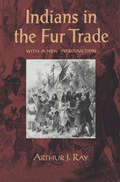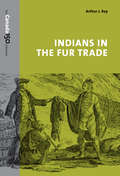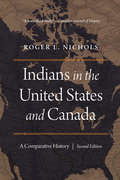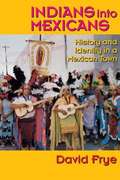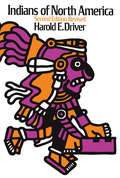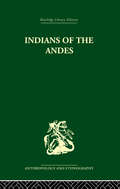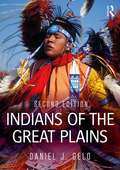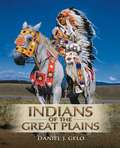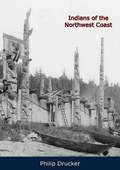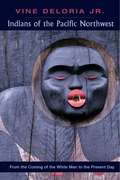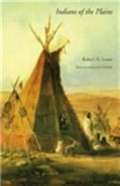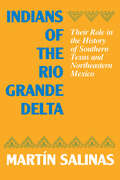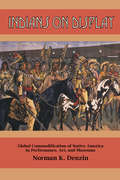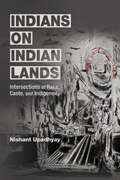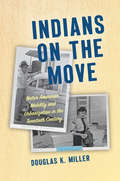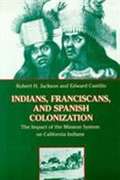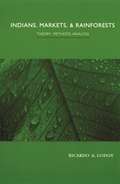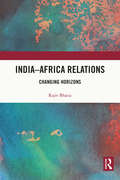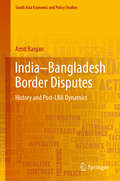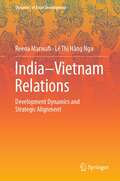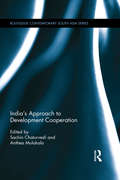- Table View
- List View
Indians in Color: Native Art, Identity, and Performance in the New West
by Norman K DenzinIn Indians in Color, noted cultural critic Norman K. Denzin addresses the acute differences in the treatment of artwork about Native America created by European-trained artists compared to those by Native artists. In his fourth volume exploring race and culture in the New West, Denzin zeroes in on painting movements in Taos, New Mexico over the past century. Part performance text, part art history, part cultural criticism, part autoethnography, he once again demonstrates the power of visual media to reify or resist racial and cultural stereotypes, moving us toward a more nuanced view of contemporary Native American life. In this book, Denzin-contrasts the aggrandizement by collectors and museums of the art created by the early 20th century Taos Society of Artists under railroad sponsorship with that of indigenous Pueblo painters;-shows how these tensions between mainstream and Native art remains today; and-introduces a radical postmodern artistic aesthetic of contemporary Native artists that challenges notions of the “noble savage.”
Indians in Kenya
by Sana AiyarSana Aiyar chronicles the strategies by which Indians sought a political voice in Kenya, from the beginning of colonial rule to independence. She examines how the strands of Indians' diasporic identity influenced Kenya's leadership--from partnering with Europeans to colonize East Africa, to collaborating with Africans to battle racial inequality.
Indians in the Family: Adoption and the Politics of Antebellum Expansion
by Dawn PetersonThrough stories of a dozen white adopters, adopted Indian children, and their Native parents in early America, Dawn Peterson shows the role adoption and assimilation played in efforts to subdue Native peoples. As adults, adoptees used their education to thwart U.S. claims to their homelands, setting the stage for the Indian Removal Act of 1830.
Indians in the Fur Trade
by Arthur RayFirst published in 1974, this best-selling book was lauded by Choice as 'an important, ground-breaking study of the Assiniboine and western Cree Indians who inhabited southern Manitoba and Saskatchewan' and 'essential reading for anyone interested in the history of the Canadian west before 1870.' Indians in the Fur Trade makes extensive use of previously unpublished Hudson's Bay Company archival materials and other available data to reconstruct the cultural geography of the West at the time of early contact, illustrating many of the rapid cultural transformations with maps and diagrams. Now with a new introduction and an update on sources, it will continue to be of great use to students and scholars of Native and Canadian history.
Indians in the Fur Trade: Their Roles as Trappers, Hunters, and Middlemen in the Lands Southwest of Hudson Bay, 1660-1870
by Arthur RayFirst published in 1974, this best-selling book was lauded by Choice as 'an important, ground-breaking study of the Assiniboine and western Cree Indians who inhabited southern Manitoba and Saskatchewan' and 'essential reading for anyone interested in the history of the Canadian west before 1870.' Indians in the Fur Trade makes extensive use of previously unpublished Hudson's Bay Company archival materials and other available data to reconstruct the cultural geography of the West at the time of early contact, illustrating many of the rapid cultural transformations with maps and diagrams. Now with a new introduction and an update on sources, it will continue to be of great use to students and scholars of Native and Canadian history.
Indians in the United States and Canada: A Comparative History, Second Edition
by Roger L. NicholsDrawing on a vast array of primary and secondary sources, Roger L. Nichols traces the changing relationships between Native peoples and whites in the United States and Canada from colonial times to the present. Dividing this history into five stages, beginning with Native supremacy over European settlers and concluding with Native peoples’ political, economic, and cultural resurgence, Nichols carefully compares and contrasts the effects of each stage on Native populations in the United States and Canada. This second edition includes new chapters on major transformations from 1945 to the present, focusing on social issues such as transracial adoption of Native children, the uses of national and international media to gain public awareness, and demands for increasing respect for tribal religious practices, burial sites, and historic and funerary remains.
Indians into Mexicans: History and Identity in a Mexican Town
by David FryeThe people of Mexquitic, a town in the state of San Luis Potosí in rural northeastern Mexico, have redefined their sense of identity from "Indian" to "Mexican" over the last two centuries. In this ethnographic and historical study of Mexquitic, David Frye explores why and how this transformation occurred, thereby increasing our understanding of the cultural creation of "Indianness" throughout the Americas.<P><P>Frye focuses on the local embodiments of national and regional processes that have transformed rural "Indians" into modern "Mexicans": parish priests, who always arrive with personal agendas in addition to their common ideological baggage; local haciendas; and local and regional representatives of royal and later of national power and control. He looks especially at the people of Mexquitic themselves, letting their own words describe the struggles they have endured while constructing their particular corner of Mexican national identity.
Indians of North America
by Harold E. DriverThe art of reconstructing civilizations from the artifacts of daily life demands integrity and imagination. Indians of North America displays both in its description of the enormous variation of culture patterns among Indians from the Arctic to Panama at the high points of their histories--a variation which was greater than that among the nations of Europe. For this second edition, Harold Driver made extensive revisions in chapter content and organization, incorporating many new discoveries and interpretations in archeology and related fields. He also revised several of the maps and added more than 100 bibliographical items. Since the publication of the first edition, there has been an increased interest in the activities of Indians in the twentieth century; accordingly, the author placed much more emphasis on this period.
Indians of the Andes: Aymaras and Quechuas (Routledge Library Editions)
by Harold OsborneThis book traces the history and ecology of the Aymaras and the Quechuas: the highland peoples of the Central Andes, who formed the nucleus of the great Inca Empire which extended for two thousand miles along the Pacific coast to the fringes of the tropical interior. In twenty millennia the Indians of the Andes had had no cultural contacts with the Old World yet they had already passed independently through stages of development usually associated with the Neolithic Age and had achieved a degree of technical and artistic excellence. In four centuries of contact there has of course been appreciable acculturation and osmosis. Originally published in 1952.
Indians of the Great Plains
by Daniel J. GeloThis book provides a thorough and engaging study of Plains Indian life. It covers both historical and contemporary aspects and contains wide and balanced treatment of the many different tribal groups, including Canadian and southern populations. Daniel J. Gelo draws on years of ethnographic research and emphasizes that Plains societies and cultures are continuing, living entities. The second edition has been updated to take account of recent developments and current terminology. The chapters feature a range of illustrations, maps, and text boxes, as well as summaries, key terms, and questions to support teaching and learning. It is an essential text for courses on Indians of the Great Plains and relevant for students of anthropology, archaeology, history, and Indigenous studies.
Indians of the Great Plains
by Daniel J. GeloPlains Societies and CulturesIndians of the Great Plains, written by Daniel J. Gelo of The University of Texas at San Antonio, is a text that emphasizes that Plains societies and cultures are continuing, living entities. Through a topical exploration, it provides a contemporary view of recent scholarship on the classic Horse Culture Period while also bringing readers up-to-date with historical and cultural developments of the 20th and 21st centuries. In addition, it contains wide and balanced coverage of the many different tribal groups, including Canadian and southern populations. Teaching & Learning Experience: Improve Critical Thinking - Indians of the Great Plains provides recent scholarship and up-to-date historical and cultural developments of the twentieth and twenty-first centuries to see the Plains societies and cultures as continuing, living entities -- including charts showing tribal organization and kinship systems. Engage Students -- Indians of the Great Plains features excerpts of Native poetry, songs, and ethnographic accounts, as well as Chapter Summaries and End-of-Chapter Review Questions.
Indians of the Northwest Coast
by Philip DruckerWritten by an outstanding authority and profusely illustrated, this is a comprehensive study of the Indians that lived from Yakutat Bay in Alaska to the northern coast of California. Originally published in the Anthropological Handbooks Series of The American Museum of Natural History, this volume vividly recreates the complexities and attainments of this unique culture of aboriginal America.The author first describes the land, people, and prehistory of the area and then considers each aspect of the culture: social structures and marriage customs, economy and technology, religion, rituals, art, wars, and feuds.Philip Drucker, an authority on the ethnology of the Pacific Coast, was educated at the University of California and was formerly with the Bureau of American Ethnology of The Smithsonian Institution in Washington, D.C.Illustrated with over 70 drawings
Indians of the Pacific Northwest
by Vine Deloria Jr. Steve Pavlik Billy Frank JrThe Pacific Northwest was one of the most populated and prosperous regions for Native Americans before the coming of the white man. By the mid-1800s, measles and smallpox decimated the Indian population, and the remaining tribes were forced to give up their ancestral lands. Vine Deloria Jr., named one of the most influential religious thinkers in the world, tells the story of these tribes' fight for survival, one that continues today. Billy Frank Jr. was the first recipient of Indian Country Today's American Indian Visionary Award. Steve Pavlik is a professor of Native American studies at Northwest Indian College.
Indians of the Plains
by Robert H. LowieRobert H. Lowie's Indians of the Plains surveys in a lucid and concise fashion the history and culture of the Indian tribes between the Mississippi and the Rocky Mountains. The author visited various tribes from 1906 to 1931, observing them carefully, participating in their lifeways, studying their languages, and listening to their legends and tales. After a half century of study, Lowie wrote this book, praised by anthropologists as the synthesis of a lifetime's work.
Indians of the Rio Grande Delta: Their Role in the History of Southern Texas and Northeastern Mexico (Texas Archaeology and Ethnohistory Series)
by Martín SalinasCertain to become a standard reference in its field, Indians of the Rio Grande Delta is the first single-volume source on these little-known peoples. Working from innumerable primary documents in various Texan and Mexican archives, Martin Salinas has compiled data on more than six dozen named groups that inhabited the area in the sixteenth through the eighteenth centuries. Depending on available information, he reconstructs something of their history, geographical range and migrations, demography, language, and culture. He also offers general information on various unnamed groups of Indians, on the lifeways of the indigenous peoples, and on the relations between the Indian groups and the colonial Spanish missions in the region.
Indians of the Rio Grande Delta: Their Role in the History of Southern Texas and Northeastern Mexico (Texas Archaeology and Ethnohistory Series)
by Martín SalinasThe first detailed archival study of the indigenous populations of the early historic period in the Lower Rio Grande Valley of Texas and Mexico. Certain to become a standard reference in its field, Indians of the Rio Grande Delta is the first single-volume source on these little-known peoples. Working from innumerable primary documents in various Texan and Mexican archives, Martín Salinas has compiled data on more than six dozen named groups that inhabited the area in the sixteenth through the eighteenth centuries. Depending on available information, he reconstructs something of their history, geographical range and migrations, demography, language, and culture. He also offers general information on various unnamed groups of indigenous people, their lifeways, and on the relations between the them and the colonial Spanish missions in the region. &“The scholarship is nothing short of superb . . . Salinas has produced the definitive work on the area, which has been needed for years.&” —Rudolph C. Troike, Professor, Department of English, University of Arizona
Indians on Display: Global Commodification of Native America in Performance, Art, and Museums
by Norman K DenzinEven as their nations and cultures were being destroyed by colonial expansion across the continent, American Indians became a form of entertainment, sometimes dangerous and violent, sometimes primitive and noble. Creating a fictional wild west, entrepreneurs then exported it around the world. Exhibitions by George Catlin, paintings by Charles King, and Wild West shows by Buffalo Bill Cody were viewed by millions worldwide. Norman Denzin uses a series of performance pieces with historical, contemporary, and fictitious characters to provide a cultural critique of how this version of Indians, one that existed only in the western imagination, was commodified and sold to a global audience. He then calls for a rewriting of the history of the American west, one devoid of minstrelsy and racist pageantry, and honoring the contemporary cultural and artistic visions of people whose ancestors were shattered by American expansionism.
Indians on Indian Lands: Intersections of Race, Caste, and Indigeneity (NWSA / UIP First Book Prize)
by Nishant UpadhyayWinner of a NWSA/University of Illinois Press First Book Prize Nishant Upadhyay unravels Indian diasporic complicity in its ongoing colonialist relationship with Indigenous peoples, lands, and nations in Canada. Upadhyay examines the interwoven and simultaneous areas of dominant Indian caste complicity in processes of settler colonialism, antiblackness, capitalism, brahminical supremacy, Hindu nationalism, and heteropatriarchy. Resource extraction in British Columbia in the 1970s–90s and in present-day Alberta offer examples of spaces that illuminate the dispossession of Indigenous peoples and simultaneously reveal racialized, gendered, and casted labor formations. Upadhyay juxtaposes these extraction sites with examples of anticolonial activism and solidarities from Tkaronto. Analyzing silence on settler colonialism and brahminical caste supremacy, Upadhyay upends the idea of dominant caste Indian diasporas as racially victimized and shows that claiming victimhood denies a very real complicity in enforcing other power structures. Exploring stories of quotidian proximity and intimacy between Indigenous and South Asian communities, Upadhyay offers meditations on anticolonial and anti-casteist ways of knowledge production, ethical relationalities, and solidarities. Groundbreaking and ambitious, Indians on Indian Lands presents the case for holding Indian diasporas accountable for acts of violence within a colonial settler nation.
Indians on the Move: Native American Mobility and Urbanization in the Twentieth Century (Critical Indigeneities)
by Douglas K. MillerIn 1972, the Bureau of Indian Affairs terminated its twenty-year-old Voluntary Relocation Program, which encouraged the mass migration of roughly 100,000 Native American people from rural to urban areas. At the time the program ended, many groups--from government leaders to Red Power activists--had already classified it as a failure, and scholars have subsequently positioned the program as evidence of America's enduring settler-colonial project. But Douglas K. Miller here argues that a richer story should be told--one that recognizes Indigenous mobility in terms of its benefits and not merely its costs. In their collective refusal to accept marginality and destitution on reservations, Native Americans used the urban relocation program to take greater control of their socioeconomic circumstances. Indigenous migrants also used the financial, educational, and cultural resources they found in cities to feed new expressions of Indigenous sovereignty both off and on the reservation. The dynamic histories of everyday people at the heart of this book shed new light on the adaptability of mobile Native American communities. In the end, this is a story of shared experience across tribal lines, through which Indigenous people incorporated urban life into their ideas for Indigenous futures.
Indians, Franciscans, and Spanish Colonization: The Impact Of The Mission System On California Indians
by Robert Jackson Edward CastilloThis ethnohistory, now in paperback, examines Indian life in the twenty-one missions Franciscans established in Alta California. In describing how the missions functioned between 1769 and 1848, the authors draw on previously unused sources to analyze change and continuity in Indian material culture and religious practices. The twin goals of Franciscans were to mold Indians into a work force that would produce surplus grain for military garrisons and to regulate their moral conduct and religious practices. The authors use production records to show the missions were quite effective in serving the economic goals. Also carefully assessed are the efforts to transform the culture and world view of Indians by delineating how they coped, their history of disease and death, and their efforts at resistance.
Indians, Markets, and Rainforests: Theoretical, Comparative, and Quantitative Explorations in the Neotropics
by Ricardo GodoyThis book addresses two important and related questions: does participation in a market economy help or hurt indigenous peoples and how does it affect the conservation of tropical rainforest flora and fauna? Oddly, there have been few quantitative studies that have addressed these issues.Ricardo Godoy's research takes an important step toward rectifying this oversight by investigating five different lowland Amerindian societies of tropical Latin America—all of which are experiencing deep changes as they modernize. Godoy examines the effect of markets on a broad range of areas including health, conservation of flora and fauna, leisure, folk knowledge, reciprocity, and private time preference. He concludes that, contrary to considerable anthropological theory, the effect of markets on the quality of life and the rainforest are often unclear or benign. Godoy uses multivariate techniques to examine the changes modernization has had on many indicators of the quality of life and the environment and concludes that the seeds of socioeconomic differentiation may already lie dormant in simple economies.The impact of modernization on lowland Amerindians is a topic of great concern to anthropologists, researchers, and policymakers in developing nations, and this book is a significant contribution to the debate about the likely future of indigenous people.
India–Africa Relations: Changing Horizons
by Rajiv BhatiaThis book explores the emergence and assertion of Africa as a significant actor and stakeholder in global affairs and the transformation of the India–Africa relationship. Beginning from this strategic perspective, the book presents an in-depth exploration of India–Africa partnership in all its critical dimensions. It delineates the historical backdrop and shared colonial past to focus on and contextualise the evolution of the India–Africa engagement in the first two decades of the 21st century. The book scrutinises the unfolding international competition in Africa in depth, which includes global actors such as the EU, US, and Japan, among others, focusing especially on China's growing influence in the region. Further, it dissects objectively the continental, regional and bilateral facets of India–Africa relations and offers a roadmap to strengthen and deepen the relationship in the coming decade. This volume will be very useful for students and researchers working in the field of international relations, foreign policy, governance, geopolitics, and diplomacy.
India–Bangladesh Border Disputes: History And Post-lba Dynamics (South Asia Economic and Policy Studies)
by Amit RanjanThis book discusses history of mental construction of the border between India and Bangladesh. It investigates how and when a border was constructed between the people, and discusses how the mental construction preceded the physical construction. It also examines the perils faced by those forced to leave their homes as a result of the partition of India in 1947. Globally throughout history, the absence of borders made the movement of people from one place to another easier. The construction of borders and sovereign de-limitation of territory restricted or even prevented seamless migration. The situation becomes more complex near borders that were previously open to the movement of people. One such border is between India and Bangladesh, where, in August 1947, suddenly people were told that the places they used to visit on a daily basis were now a part of a different sovereign country. This book argues that borders construct the identity of an individual or a group. Those who cross to the other side of border, for whatever reason, are identified and categorized by the state and the people. Sometimes these migrants face violence from the locals because they are considered a threat to the local working class. The book also explains how, after the liberation of Bangladesh in 1971, everyday encounter between people from India and Bangladesh have further embedded a feeling of us versus them. In 2015, India and Bangladesh agreed to implement the India–Bangladesh Land Border Agreement (LBA). This book assesses whether the implementation of this agreement will have impacts on border-related problems like mobility, migration, and tensions. It is a valuable resource for policymakers, journalists, researchers and students.
India–Vietnam Relations: Development Dynamics and Strategic Alignment (Dynamics of Asian Development)
by Reena Marwah Lê Thị Hằng NgaThis book provides an in-depth analysis of the close cultural links between India and Vietnam. It discusses the issues of trade negotiations under the Regional Comprehensive Economic Partnership (RCEP) and the Indo-Pacific construct. Issues such as strengthening the economic partnership, contemporary development challenges posed by the COVID-19 pandemic, including weakening supply chains, and geo-strategic tensions are explored in this book. It enriches understanding of the potential of the two countries to develop as manufacturing hubs for the region and beyond. Given the more aggressive posturing by China in 2020, the concluding chapter includes the policy prescriptions with a futuristic vision, for India and Vietnam to catalyze their strategic and bilateral partnership. Well researched and analytical, the book draws extensively from several interviews of experts, diplomats, journalists, businesspersons, and members of the diaspora. It is a must read for students, researchers, think tanks, area study centers, and all institutions engaged in Asian studies, encompassing narratives extending from the developmental to political, from the bilateral to the multilateral and from the geo-economic to the geo-strategic.
India’s Approach to Development Cooperation (Routledge Contemporary South Asia Series)
by Sachin Chaturvedi Anthea MulakalaIndia is emerging as a key player in the development cooperation arena, not only because of the increasing volume and reach of its south-south cooperation but more so because of its leadership and advocacy for the development of a distinctly southern development discourse and knowledge generation. This book traces and analyses the evolution of Indian development cooperation. It highlights its significance both to global development and as an effective tool of Indian foreign policy. Focussing on how India has played an important role in supporting development efforts of partner countries in South Asia and beyond through its various initiatives in the realm of development cooperation, the book tracks the evolution, genesis, and the challenges India faces in the current international context. The contributions provide a rich mix of academic and government, policy and practice, Indian and external perspectives. Theory is complemented with empirical research, and case studies on countries and sectors as well as comparisons with other aid providing countries are presented. The book is of interest to researchers and policy makers in the field of development cooperation, the role of emerging powers from the South, international development, foreign policy and global political economy.
